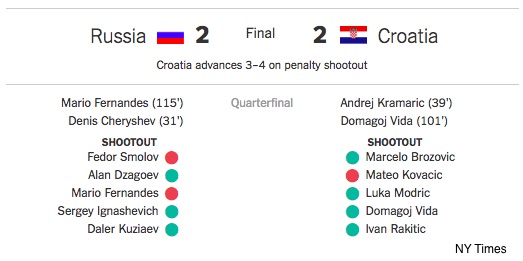Yesterday Croatia defeated Russia in a World Cup quarter-finals penalty shootout.
When the score is tied after playing time has expired, the penalty shootout determines the winner. It involves just two players, the kicker and the goalie. Alternating five kicks apiece, each team’s objective is more goals than the opposition. Essentially we have a goalie trying to block a kick and the player trying to get the ball past him into the net.
Here is where the economics enters the game.
Game Theory
Sometimes you have to know what your opponent will do in order to decide how to act. The problem though is that it’s all a prediction. You have to figure out your response before you know what to respond to. What you do can be explained by game theory.
Prison
A classic example of game theory is called the prisoner’s dilemma. When two partners in crime are arrested, one knows that if he confesses and his partner does not, then he will go free. But if both keep quiet, they both go to jail for one year. Because they are questioned separately, no one knows what the other has said. But the results depend on how much the other person admitted.
The dilemma: Keep quiet or confess?
Business
When big businesses compete, game theory can explain their pricing strategy. Assume that one guesses that the other will raise prices so it does too. If both up them, then they both benefit. But if one does not, then the other will lose business.
The dilemma: Increase prices or maintain them?
World Cup
Similarly, in a penalty shootout, the goalie has to decide whether to lunge to the left, the right, or remain in the middle. At the same moment, the kicker knows if he will aim for the left, the right, or the middle. With no time to react to the other’s decision, they each need to figure it out beforehand. Called a zero-sum game, there can be only one winner. At stake are huge amounts of money, of ego, and perhaps a championship.
The dilemma: Select the right, the left, or the middle?
And that is the essence of game theory. You are trying to understand opponents’ behavior (which could be an individual, a firm or a country) and also how those of us beyond the decision-makers are affected.
Our Bottom Line: World Cup Game Theory
According to economists who have researched World Cup game theory, the best strategy appears to be no strategy (aka a mixed strategy). The reason? If a kicker has a strong side, the goalie could expect the ball to go there. But on the other hand, the kicker would know that and use his weaker side…Or not.
So, referring to the Croatian shootout decisions, an economist would say that the players’ choices were “serially independent.”
My sources and more: For the details on the Russia-Croatia match, this NY Times article is one of many possibilities. Meanwhile, in 2014, Quartz focused on soccer game theory. But if you want some thorough analysis, do look at this 2002 paper from Brown and this one from economists at the University of Chicago. Finally, The Economist has a good discussion of how game theory works while this obituary introduces you to its originator, John Nash and A Beautiful Mind.








